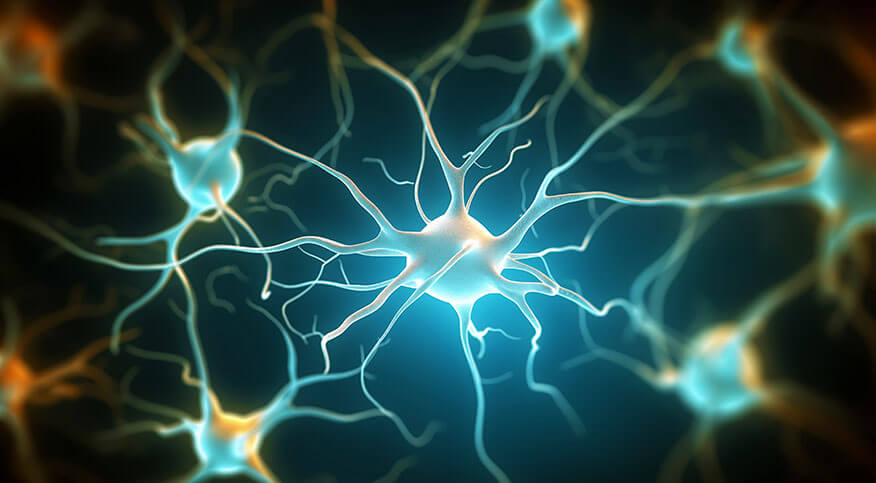Purdue and UPenn research finds link between aging, fat accumulation in the brain

With age, some cells in the brain enter a state of senescence: rather than dying or regenerating by dividing, they just linger, alive, but functioning less effectively than normal cells. Senescence in the brain has been linked to cognitive decline, and senescent cells are targets for antiaging therapies, but researchers know little about how such cells appear and function in living organisms. Now, in a finding which may help to address aging-related disease, an interdisciplinary team — which at Purdue University was led by researcher Gaurav Chopra — discovered that diminishing energy production in aging neurons triggers senescence in nearby glial cells, which ordinarily support and protect neurons.
The changes to the glial cells, in turn, cause an increase in fat accumulation in neighboring, healthy glial cells, a state which is increasingly tied to age-related diseases.
“This work suggests that controlling senescent glia may have positive effects on health and opens up new potential avenues for targeting aging and age-onset diseases,” said Chopra, an associate professor of chemistry and a member of the Purdue institutes for Drug Discovery, Cancer Research and Integrative Neuroscience and the Regenstrief Center for Healthcare Engineering.
The work led by China Byrns in the lab of Nancy M. Bonini at the University of Pennsylvania and published in Nature, builds on previous findings Byrns made on traumatic brain injury (TBI) in fruit flies, and previous work led by Chopra and his group on the pathways identified by lipid accumulation in glial cells. In her research, Byrns found that TBI activates a specific pathway in glial cells that is also activated as flies age. The pathway, controlled by a regulatory transcription factor AP1, is associated with the development of senescent glial cells.
Byrns and Chopra realized a collaboration could provide important insight into the lipidomic state of the glia. Chopra’s work on pathways related to the conversion of fatty acids to triacylglycerols, which are components of fat accumulated in cells, showed a dysfunctional state in glial cells.
“China was looking at the effects of TBI, but what she found was that the trauma seemed to accelerate processes that occur naturally as the flies age,” said Bonini, University of Pennsylvania professor of biology. “This led to the hypothesis that there might be a connection between the brain’s response to injury and the natural aging process, mediated through the activation of this specific pathway.”
For the new study, Byrns, with collaborators including Chopra, used a combination of tools and advanced imaging techniques to identify specific markers for senescent glial cells, isolate those cells and perform gene expression analyses to confirm their senescence status. Suspecting a link between faltering energy production in the mitochondria (the cellular powerhouse) of neurons and senescence, Byrns also induced mitochondrial dysfunction in neurons to monitor the effects on nearby glial cells. When several genes important to mitochondrial function were suppressed in the brains of young flies, senescent glial appeared.
Chopra’s lab performed large-scale lipidomics on cells isolated from young and old flies’ brains. Their work showed a relationship between senescent cells and lipid accumulation in neighboring, non-senescent glia that was related to their previous work in the mammalian system. Using an AI-based informatics analysis pipeline they developed, the scientists in Chopra’s group discovered that senescent glial cells produce specific lipids, leading to the accumulation of vesicles that store fat in non-senescent glial cells.
“The accumulation of lipids from senescence to non-senescence glia may be responsible for dysfunction of normal function of glial cells in aging and other chronic neuroinflammatory diseases,” Chopra said.
These vesicles, called lipid droplets, are thought to sequester reactive oxygen molecules that can damage cells, potentially protecting the brain. However, while the research showed that mitigating senescent glial cells can extend lifespan and improve some aspects of brain function in the flies, it also resulted in increased oxidative damage. This suggests that senescent glial cells may have some beneficial functions alongside their detrimental effects.
Chopra said that lipid droplets, or cellular “fat,” are emerging as crucial players in the pathogenesis of several diseases, yet their origin remains largely unexplored in aging and age-related diseases, such as Alzheimer’s disease and aging.
“Since these lipid-related pathways to develop lipid droplets seems to be conserved across species, including mammals, this new work suggests the important role of linking neuronal mitochondrial failure to lipid-droplet accumulation in glial cells towards pathogenesis in aging and age-onset diseases,” Chopra said.
“Senescent Glia Link Mitochondrial Dysfunction and Lipid Accumulation” was published in Nature with support of the National Institutes of Health and the U.S. Department of Defense.